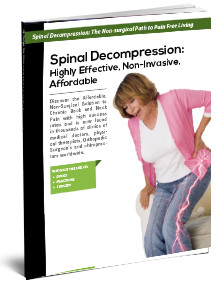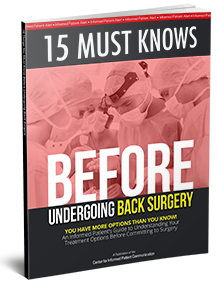Frequently Asked Questions and Answers about Back Pain, Neck Pain, and Spinal Decompression
What is Spinal Decompression?
Spinal decompression is a evolving technology that was built to treat symptoms of low back and neck pain from breached, protuberant, damaged and slipped discs. Spinal decompression is FDA-approved and was founded over 10 years ago. There have been more than 10 successful research studies on spinal decompression. there are currently more than 5,000 office pracicing spinal decompression nationwide that are performing spinal decompression therapy. Every day clinics are adding spinal decompression as an alternative and back up to getting for patients suffering from bulding, destroyed, worn, and slipped discs. Even when physical therapy, chiropractic, acupuncture, intense pain killers most and shots have not worked, most patients still receive pain relief in 6 to 7 weeks of spinal decompression.
What does Spinal Decompression treat?
FDA Approved Spinal Decompression Tech treats symptoms of back pain due to:
- Herniated Discs
- Convex Discs
- Pinched Nerves
- Sciatica (leg pain)
- Declinatory Discs
- Spinal Stenosis
- Post-Surgical Pain and more...
How Does Spinal Decompression Work?
Decompression is attained by using a sequence of motiions of pull, angle in degree of pull and manouvering time in order to build a negative force internal of the discs of the spinal cord. This reversal of force creates a vacuum inside the disc that helps to push in protruding discs and extruded disc material back in its natural spot, taking pressure off pinched or irritated nerves. Spinal professionals believe that nutrients, oxygen, and fluids are drawn into the disc to create a revitalized habitat conducive to healing for both herniated and deteriorated discs. Factored on the patient’s body weight, tolerance, level of severity, and length of time they have been having symptoms your spinal decompression doctor will determine a specific therputic treatment plan based on your personal needs. This helps ensure the healthiest results.
What are the Treatments Like?
At the beginning of each session, you will be comfortably fitted with a harness designed to achieve optimal decompression of the low back or neck. During a session of spinal decompression, you will notice a slow lengthening of your spine as your discs are gradually decompressed and relieved of pressure. The treatment process is safe and relaxing. While some patients with extensively injured discs have reported mild discomfort during the first few treatment sessions, their discomfort generally subsides upon subsequent visits. A patient safety switch provides an extra safety feature, allowing you to stop at any point should you feel discomfort. Each treatment session lasts approximately 30 minutes.
What is the Typical Treatment Protocol?
A typical spinal decompression treatment protocol consists of about 12–20 sessions over four to six weeks. Some conditions require fewer visits; some require more. Many patients report relief from their pain and other symptoms during the first few treatment sessions, and most experience dramatic pain relief after completion of their prescribed treatment program.
Why Would Spinal Decompression Work When Chiropractic, Physical Therapy and Traction Have Failed?
While traction, physical therapy, inversion tables and manipulation may reduce disc pressures to as low as 40 mm Hg, only spinal decompression has been shown to achieve negative pressures within the spine. It has been clinically proven that spinal decompression creates negative pressures as low as -110 mm Hg3 within the injured disc during the treatment session. Normally, pulls exerted on the spine trigger sensory receptors in the back to tighten the muscles surrounding the vertebrae and discs in an effort to protect them from injury, a mechanism in the body known as the proprioceptor response. This typically includes muscle guarding and muscle spasms. Spinal Decompression bypasses this response by slowly pulling on the spine and relaxing the back over an extended period of time, allowing the discs to be repositioned without tension and without setting off muscle guarding and spasms. It is important for patients to make sure that they are treated on a high quality spinal decompression table by a physician with years of experience and not an imitation spinal decompression table to ensure best results.
If I Undergo Spinal Decompression Therapy, How Long Will It Take to See Results?
In view of 6 years of spinal decompression experience a huge number of patients treated we have seen that general achievement rate is around 80%. We consider this achievement rate to be generally excellent considering the majority of our patients have” with minimal or no relief, are at least a 6/10 mVAS pain level and have been experiencing their pain for more than 6 weeks.About 20% of patients will begin seeing help of agony inside the principal week. Around 40% of patients will include huge alleviation inside 2–3 weeks. The staying 20% will get critical alleviation between 4 a month and a half. Under 20% will encounter no alleviation or negligible help. Rarely will a patient deteriorate.
Do I Qualify for Spinal Decompression Therapy Treatment?
he following conditions may meet all requirements for spinal decompression treatment. Continuously counsel your spinal decompression master to check whether you are a contender for spinal decompression treatment. Possibility for spinal decompression treatment incorporate the accompanying::
- Diagnosis of a herniated, bulging or degenerated disc
- Back pain persisting for more than three weeks
- Recurrent pain from a failed back surgery that is more than six months old
- Persistent pain from arthritis
- Patient at least 18 years of age
Who doesn’t qualify for spinal decompression therapy?
The following conditions may disqualify a patient for spinal decompression treatment. Always consult your spinal decompression specialist to see if you are a candidate for spinal decompression therapy. Candidates that may not qualify for spinal decompression therapy include the following:
- Surgery or metal in the spine such as screws and rods
- Pregnant with a child
- Prior lumbar fusion less than 5 and a half
- Metastatic cancer (cancer that has spread to the bones
- Grade 3 and 4 spondylolisthesis (Grade 1 or Grade 2 spondylolisthesis are treatable)
- Recent compression fracture of lumbar spine
- Pathologic aortic aneurysm
- Pelvic or abdominal cancer
- Disc space infections
Consult your physician if you have any questions about the conditions above or to find out if you would qualify for spinal decompression therapy.
Are there any Side Effects to the Treatment?
Most patients dont encounter any significant symptoms. The most widely recognized reaction is a dull, throbbing irritation for the main week or two as the body gets familiar with being extended and decompressed. Spinal decompression extends muscles in a stretching bearing which the body is commonly not used to. In view of this patients may encounter a dull, throbbing irritation that they regularly depict as “it feels like I just turned out without precedent for a long time.” Very seldom do patients have an expansion in the agony that they came in with.
Patients with acute, severe disc herniations may experience some pain during the first week or two until the herniation retracts back in taking pressure off of the nerves. Acute disc herniation patients tend to experience more “up and down” types of relief from their pain for the first 2 weeks as an acute disc herniation can be slightly unpredictable. Regardless of the mild soreness experienced in the first week or two, most patients experience 50% relief or more of their pain around the end of the second week.
In general Spinal Decompression Therapy is viewed as protected and agreeable. The framework has crisis stop switches for both the patient and the administrator. These switches end the treatment quickly if a patient encounters any expansion in agony or uneasiness during the treatment consequently maintaining a strategic distance from most wounds
Can Spinal Decompression be Used for Patients that Have had Spinal Surgery?
Much of the time Spinal Decompression treatment isn't contra-shown (retained because of the damage that it would cause the patient) for patients that have had spinal medical procedure. Truth be told numerous patients have discovered accomplishment with Spinal Decompression significantly after a flopped back medical procedure. After a bombed Laminectomy or Micro Discectomy patients may in any case react well to spinal decompression. On the off chance that a patient has had multiple laminectomies, at that point the achievement pace of spinal decompression will go down. On the off chance that a patient has had careful combination with bars or screws or any sort of equipment then patients may not fit the bill for spinal decompression. Continuously counsel your spinal decompression pro to check whether you fit the bill for spinal decompression treatment.


Free Reports
Learn how Spinal Decompression and our programs are changing the way Neck and Back pain are treated, without the use of toxic medications, injections, or surgery.
How Do I Know If I am Eligible For Care?
Call Us Today to Schedule YOUR Consultation!
(323) 643-5713
We offer natural health solutions to care for many conditions such as Neck/back pain, herniated or bulging discs, spinal stenosis, sciatica, radiculopathy/neuropathy, chronic fatigue, headaches, and more.
To learn more about our individualized comprehensive programs offered throughout Los Angeles, Beverly Hills, Santa Monica, Culver City, Sherman Oaks, Hollywood, Brentwood, Westwood, Pacific Palisades, Malibu, Manhattan Beach, Torrence, Glendale, Pasadena, Los Angeles, or San Diego, California; read our testimonials and spinal decompression reviews from many satisfied patients.
Call us to schedule a complimentary consultation to determine if you are a candidate for Spinal Decompression and our multi-step Protocol. The doctor will ask you a series of questions such as “Where is the pain, when did it begin, what makes it better or worse?” Then a thorough examination will be performed in which case the doctor will check your reflexes, blood pressure, balance, gait, skin, sensory changes, muscle strength and more to determine the cause of your back or neck pain. At this point the doctor may recommend x-rays or an MRI, if he feels like further imaging would be necessary to determine the exact cause. After combining all of this information together, the doctor will determine if you would make a good candidate for spinal decompression therapy and our multi-step Protocol. If you do qualify for care, your Doctor will explain the recommended plan of action for you. If for some reason you do not qualify for care, the doctor will refer you to someone who may better suit your needs.
The information on this site has not been evaluated by the FDA.

